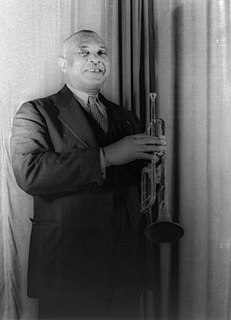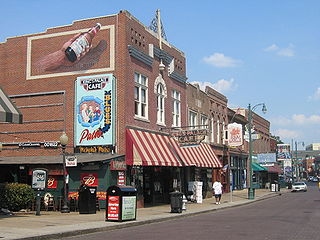Blues is a music genre and musical form which was originated in the Deep South of the United States around the 1860s by African-Americans from roots in African-American work songs and spirituals. Blues incorporated spirituals, work songs, field hollers, shouts, chants, and rhymed simple narrative ballads. The blues form, ubiquitous in jazz, rhythm and blues and rock and roll, is characterized by the call-and-response pattern, the blues scale and specific chord progressions, of which the twelve-bar blues is the most common. Blue notes, usually thirds, fifths or sevenths flattened in pitch are also an essential part of the sound. Blues shuffles or walking bass reinforce the trance-like rhythm and form a repetitive effect known as the groove.

The Original Dixieland Jass Band (ODJB) was a Dixieland jazz band that made the first jazz recordings in early 1917. Their "Livery Stable Blues" became the first jazz record ever issued. The group composed and recorded many jazz standards, the most famous being "Tiger Rag". In late 1917, the spelling of the band's name was changed to Original Dixieland Jazz Band.

William Christopher Handy was a composer and musician who referred to himself as the Father of the Blues. Handy was one of the most influential songwriters in the United States. One of many musicians who played the distinctively American blues music, Handy did not create the blues genre but was the first to publish music in the blues form, thereby taking the blues from a regional music style with a limited audience to a new level of popularity.

The Memphis blues is a style of blues music created from the 1910s to the 1930s by musicians in the Memphis area, such as Frank Stokes, Sleepy John Estes, Furry Lewis and Memphis Minnie. The style was popular in vaudeville and medicine shows and was associated with Beale Street, the main entertainment area in Memphis, W. C. Handy, the "Father of the Blues", published the song "The Memphis Blues". In lyrics, the phrase has been used to describe a depressed mood.
The story of Tennessee's contribution to American music is essentially the story of three cities: Nashville, Memphis, and Bristol. While Nashville is most famous for its status as the long-time capital of country music, Bristol is recognized as the "Birthplace of Country Music". Memphis musicians have had an enormous influence on blues, early rock and roll, R&B, and soul music, as well as an increasing presence in rap.

"The Saint Louis Blues" is a popular American song composed by W. C. Handy in the blues style and published in September 1914. It was one of the first blues songs to succeed as a pop song and remains a fundamental part of jazz musicians' repertoire. Louis Armstrong, Bing Crosby, Bessie Smith, Count Basie, Glenn Miller, Guy Lombardo, and the Boston Pops Orchestra are among the artists who have recorded it. The song has been called "the jazzman's Hamlet". Composer William Grant Still arranged a version of the song in 1916 while working with Handy.

Beale Street is a street in Downtown Memphis, Tennessee, which runs from the Mississippi River to East Street, a distance of approximately 1.8 miles (2.9 km). It is a significant location in the city's history, as well as in the history of blues music. Today, the blues clubs and restaurants that line Beale Street are major tourist attractions in Memphis. Festivals and outdoor concerts frequently bring large crowds to the street and its surrounding areas.

Walter E. "Furry" Lewis was an American country blues guitarist and songwriter from Memphis, Tennessee. He was one of the first of the blues musicians active in the 1920s to be brought out of retirement and given new opportunities to record during the folk blues revival of the 1960s.

The Memphis Jug Band was an American musical group active from the mid-1920s to the late 1950s. The band featured harmonica, kazoo, fiddle and mandolin or banjolin, backed by guitar, piano, washboard, washtub bass and jug. They played slow blues, pop songs, humorous songs and upbeat dance numbers with jazz and string band flavors. The band made the first commercial recordings in Memphis, Tennessee, and recorded more sides than any other prewar jug band.
Little is known about the exact origin of the music now known as the blues. No specific year can be cited as the origin of the blues, largely because the style evolved over a long period and existed in approaching its modern form before the term blues was introduced and before the style was thoroughly documented. Ethnomusicologist Gerhard Kubik traces the roots of many of the elements that were to develop into the blues back to the African continent, the "cradle of the blues". One important early mention of something closely resembling the blues comes from 1901, when an archaeologist in Mississippi described the songs of black workers which had lyrical themes and technical elements in common with the blues.
Classic female blues was an early form of blues music, popular in the 1920s. An amalgam of traditional folk blues and urban theater music, the style is also known as vaudeville blues. Classic blues were performed by female singers accompanied by pianists or small jazz ensembles and were the first blues to be recorded. Ma Rainey, Bessie Smith, Ethel Waters, and the other singers in this genre were instrumental in spreading the popularity of the blues.

Frank Stokes was an American blues musician, songster, and blackface minstrel, who is considered by many musicologists to be the father of the Memphis blues guitar style.
"Careless Love" is a traditional song, with several popular blues versions. It has been called a "nineteenth-century ballad and Dixieland standard".

Howard "Louie Bluie" Armstrong was an American string band and country blues musician, who played fiddle, mandolin, and guitar and sang. He was also a notable visual artist and raconteur.

"The Memphis Blues" is a song described by its composer, W. C. Handy, as a "southern rag". It was self-published by Handy in September 1912 and has been recorded by many artists over the years.

"Livery Stable Blues" is a jazz composition copyrighted by Ray Lopez (né Raymond Edward Lopez; 1889–1979) and Alcide Nunez in 1917. It was recorded by the Original Dixieland Jass Band on February 26, 1917, and, with the A side "Dixieland Jass Band One-Step" or "Dixie Jass Band One-Step", became widely acknowledged as the first jazz recording commercially released. It was recorded by the Victor Talking Machine Company in New York City at its studio at 46 West 38th Street on the 12th floor – the top floor.
Dan Sane was an American Memphis blues and country blues guitarist and songwriter. He was an associate of Frank Stokes. According to the Music journalist Jason Ankeny, "they had emerged among the most complementary duos in all of the blues, with Sane's flatpicking ideally embellished by Stokes' fluid rhythms." The best-known of the songs written by Sane are "Downtown Blues" and "Mr. Crump Don't Like It." His surname was sometimes spelled "Sain".
The Mojo Triangle, a geographical and cultural area located within a triangular connection between New Orleans, Nashville and Memphis, is the birthplace of country, blues, jazz, and rock and roll. The Mojo Triangle has creative artists, not just in music, but also in literature and films.
Joyce Renee Cobb is an American singer specializing in jazz and R&B. She is closely associated with traditional blues and jazz in the style of Memphis Minnie, Bessie Smith, Billie Holiday, and Sarah Vaughan. She has had a wide-ranging career as a solo artist and vocalist, having charted several country, pop, and R&B singles in the 1970s and early 1980s, later recording as a jazz vocalist.











